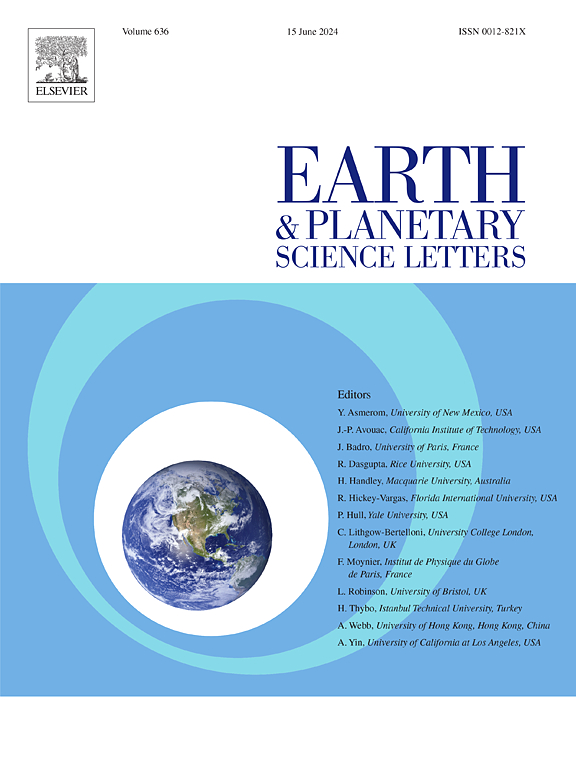CO2 flushing and redox as drivers of pre-eruptive amphibole breakdown
IF 4.8
1区 地球科学
Q1 GEOCHEMISTRY & GEOPHYSICS
引用次数: 0
Abstract
Amphibole reaction rims record critical pre-eruptive magmatic processes, including storage and ascent dynamics. Although decompression and heating are traditionally viewed as key triggers for amphibole breakdown, variations in rim textures and mineralogy indicate that multiple or fluctuating processes often operate simultaneously. This study presents experimental results demonstrating significant impacts of CO2 flushing and redox (fO2) conditions (versus heating and decompression) on amphibole reaction rim formation in rhyolitic and rhyodacitic melts at shallow crustal conditions. In experiments at 830 °C and 120 MPa, the presence of a mixed XH2O:XCO2 fluid (XCO2 = 0.3–0.7) rapidly induced a reaction, with rim thickness, grain size, aspect ratio, nucleation rate and crystal number density all increasing with CO2 concentration. In contrast, rims produced by heating (880 °C for up to 48 h) had distinct characteristics, while decompression (120 MPa to 65 MPa over 120 h) from the same starting conditions did not produce reaction rims. Increasing oxygen fugacity (fO2 from NNO+1 to RRO [NNO+2]) led to rapid rim formation within 24 h, accompanied by distinct mineralogical changes that favoured the stability of Fe3+ phases. These findings demonstrate that CO2, fO2, heating and decompression each exert unique influences on amphibole breakdown; thus, quantitative textural analysis of amphibole rims can help differentiate the driving mechanisms. Recognising the full range of factors affecting amphibole stability and an understanding of the multi-parametric controls is essential for accurately interpreting pre-eruptive conditions, enhancing our ability to reconstruct magmatic histories, and for assessing volcanic hazards.
CO2冲刷和氧化还原是爆发前角闪孔破裂的驱动因素
角闪孔反应边缘记录了喷发前的关键岩浆过程,包括岩浆的储存和上升动力学。虽然减压和加热通常被认为是角闪洞破裂的关键触发因素,但边缘结构和矿物学的变化表明,多个或波动的过程通常同时发生。本研究的实验结果表明,在浅地壳条件下,CO2冲洗和氧化还原(fO2)条件(相对于加热和减压)对流纹岩和流纹酸质熔体中角闪孔反应边缘的形成有显著影响。在830℃、120 MPa的实验条件下,XH2O:XCO2混合流体(XCO2 = 0.3 ~ 0.7)的存在快速诱导了反应,随着CO2浓度的增加,晶缘厚度、晶粒尺寸、长径比、成核速率和晶数密度均增加。相比之下,加热(880°C, 48小时)产生的轮辋具有明显的特征,而在相同的起始条件下减压(120 MPa至65 MPa, 120小时)不会产生反应轮辋。氧逸度的增加(从NNO+1到RRO [NNO+2])导致24 h内快速形成环,并伴有明显的矿物学变化,有利于Fe3+相的稳定性。这些结果表明,CO2、fO2、加热和减压对角闪孔破裂均有独特的影响;因此,对角闪孔边缘的定量结构分析有助于区分驱动机制。认识到影响角闪洞稳定性的所有因素以及对多参数控制的理解,对于准确解释爆发前的条件、增强我们重建岩浆历史的能力以及评估火山危害至关重要。
本文章由计算机程序翻译,如有差异,请以英文原文为准。
求助全文
约1分钟内获得全文
求助全文
来源期刊

Earth and Planetary Science Letters
地学-地球化学与地球物理
CiteScore
10.30
自引率
5.70%
发文量
475
审稿时长
2.8 months
期刊介绍:
Earth and Planetary Science Letters (EPSL) is a leading journal for researchers across the entire Earth and planetary sciences community. It publishes concise, exciting, high-impact articles ("Letters") of broad interest. Its focus is on physical and chemical processes, the evolution and general properties of the Earth and planets - from their deep interiors to their atmospheres. EPSL also includes a Frontiers section, featuring invited high-profile synthesis articles by leading experts on timely topics to bring cutting-edge research to the wider community.
 求助内容:
求助内容: 应助结果提醒方式:
应助结果提醒方式:


